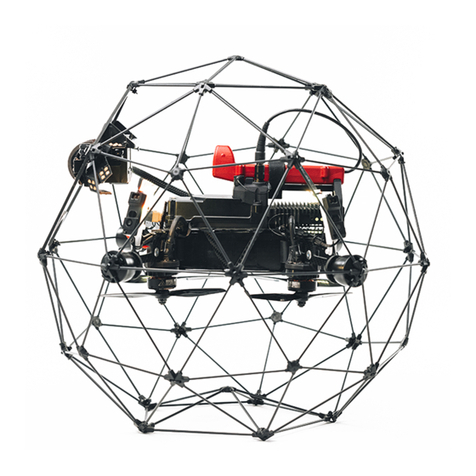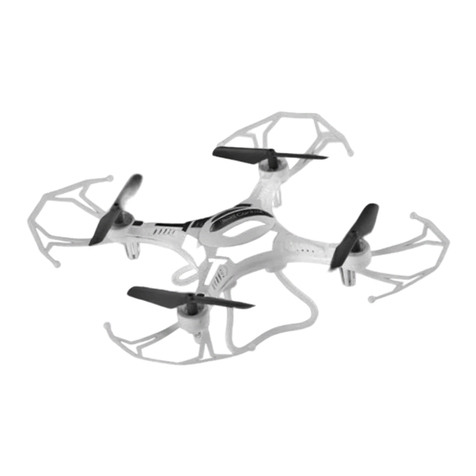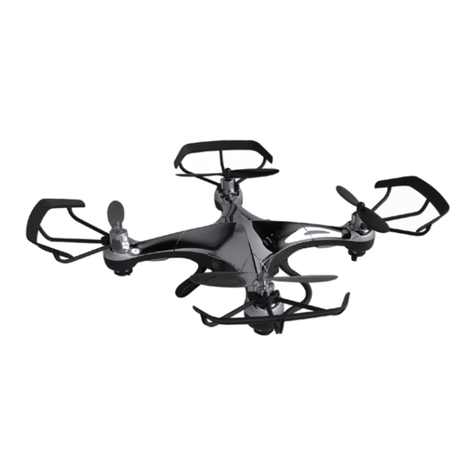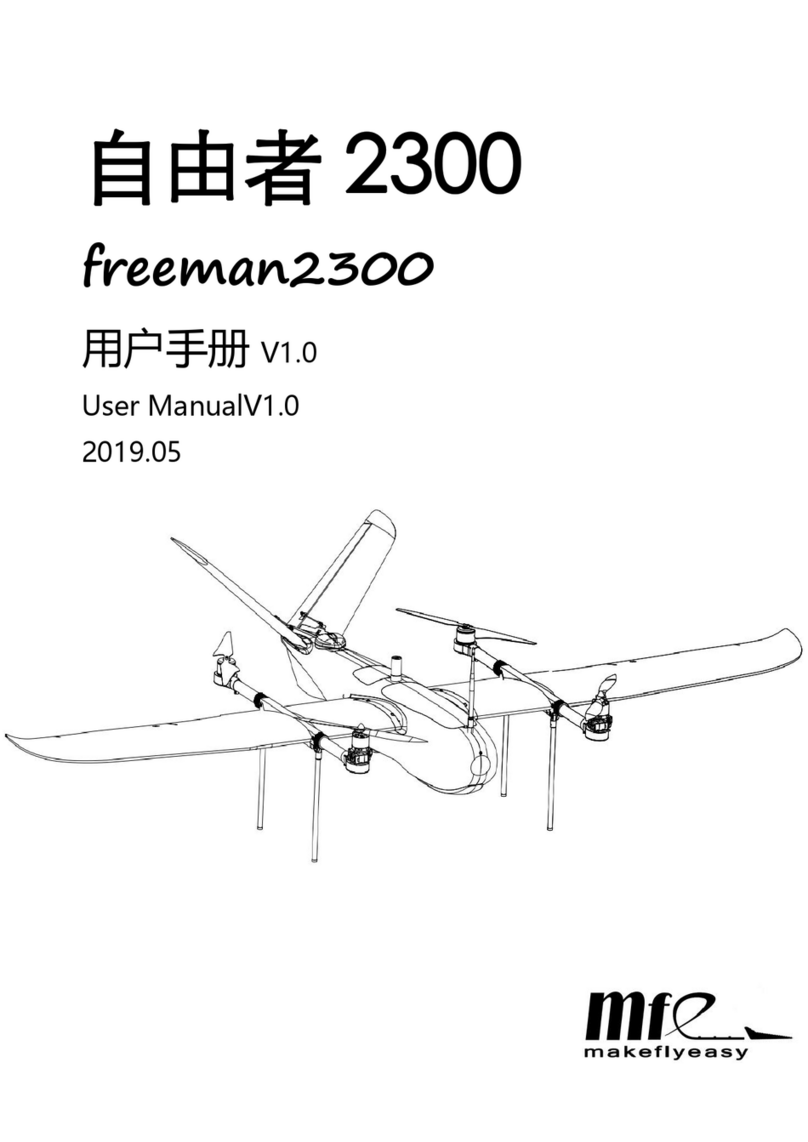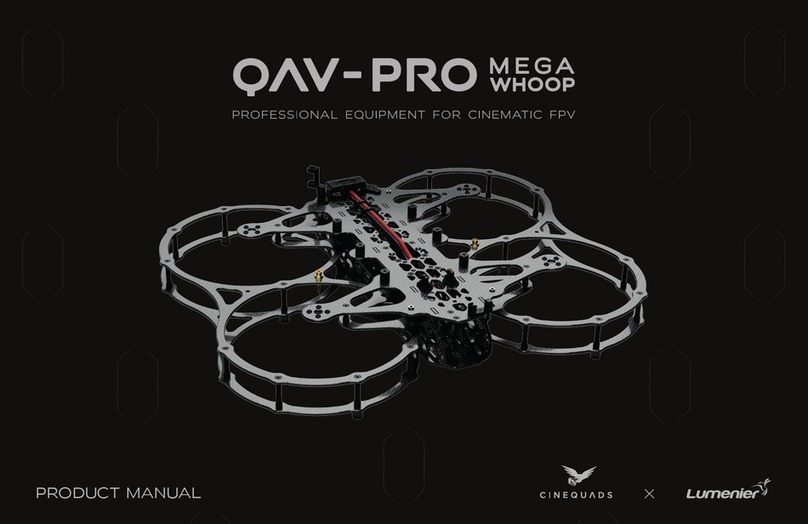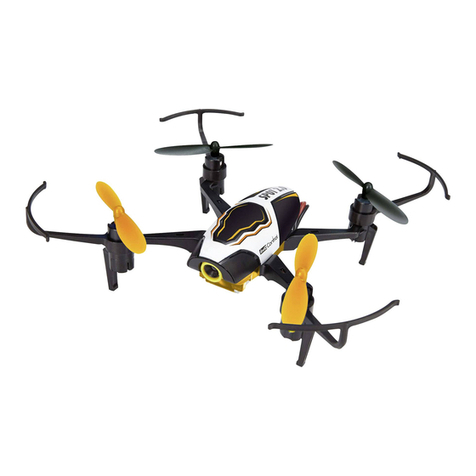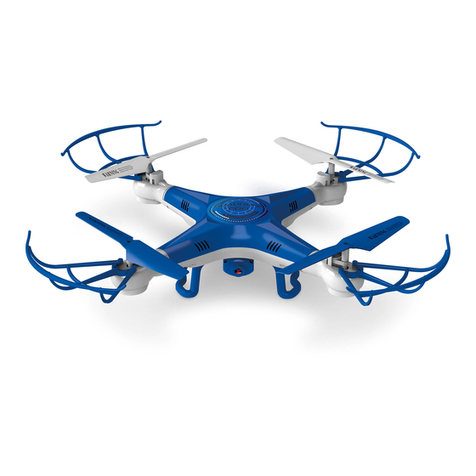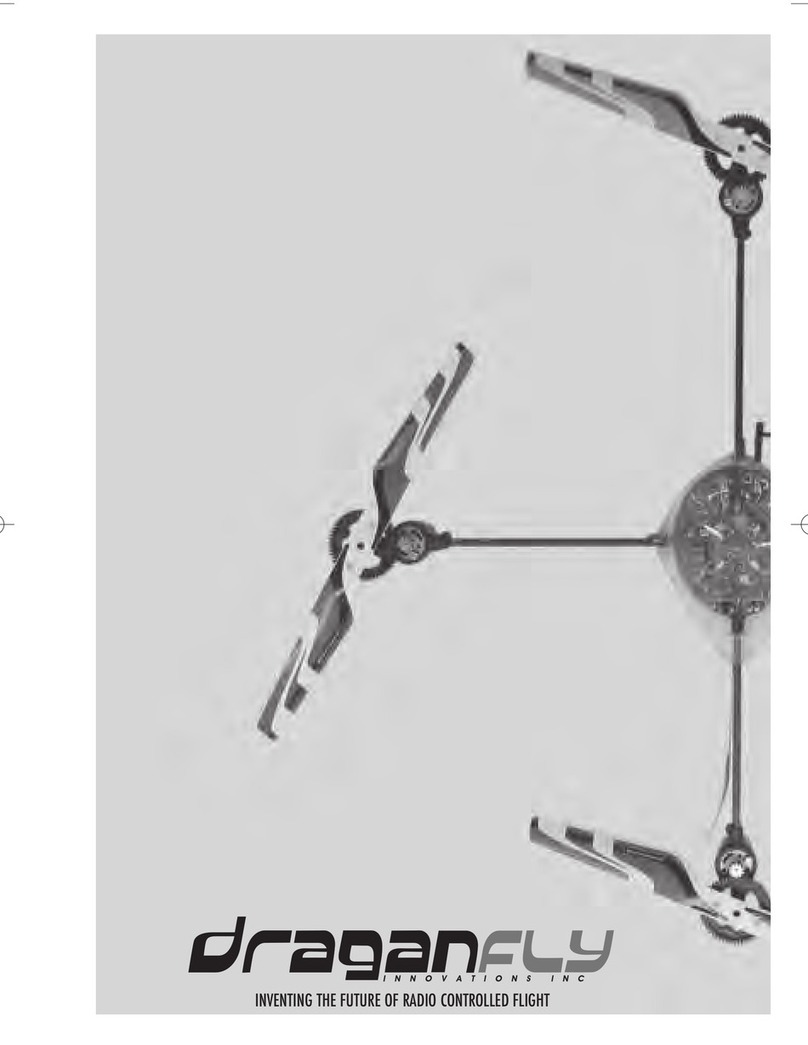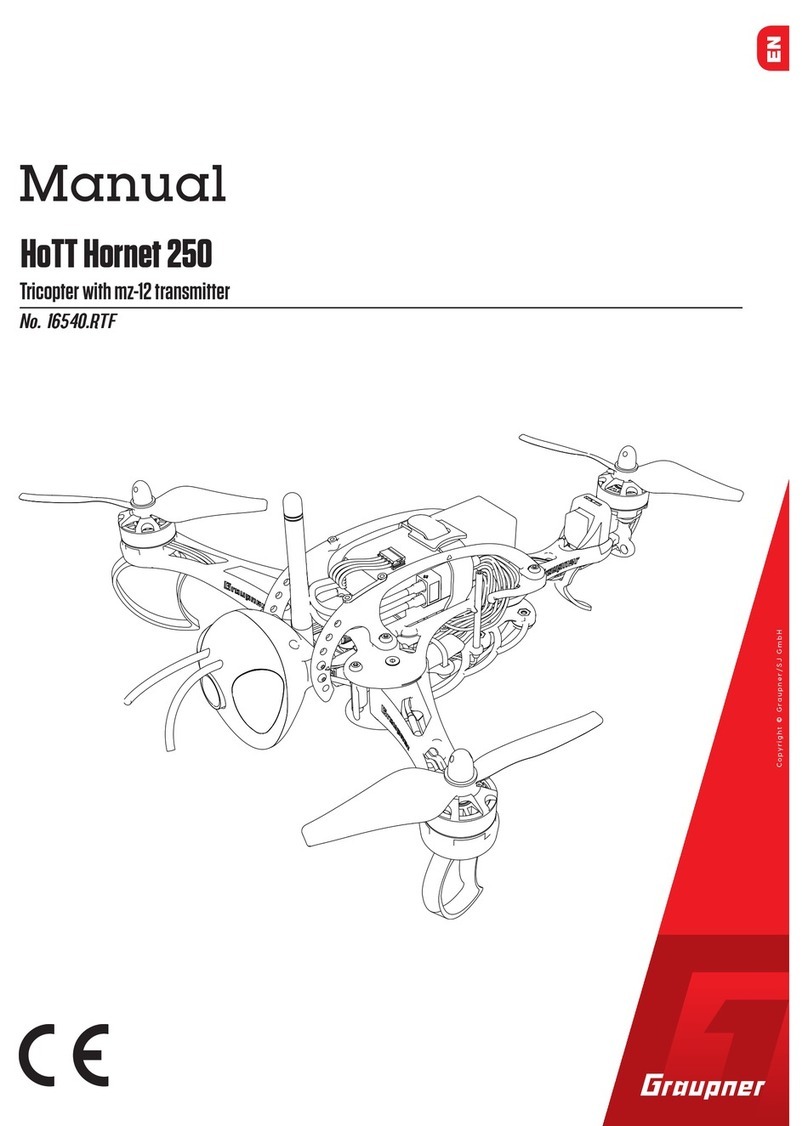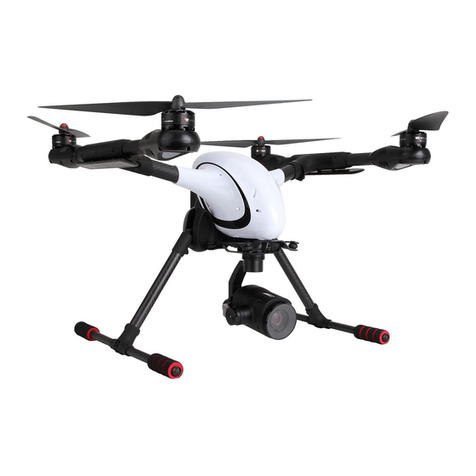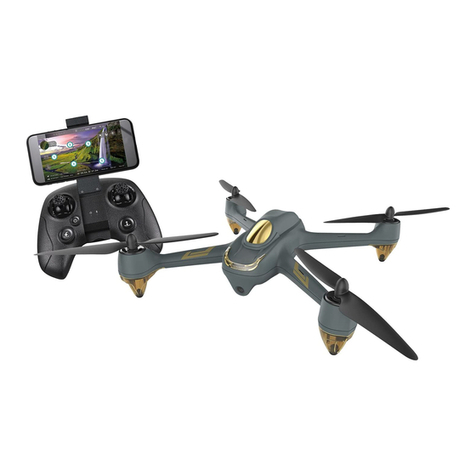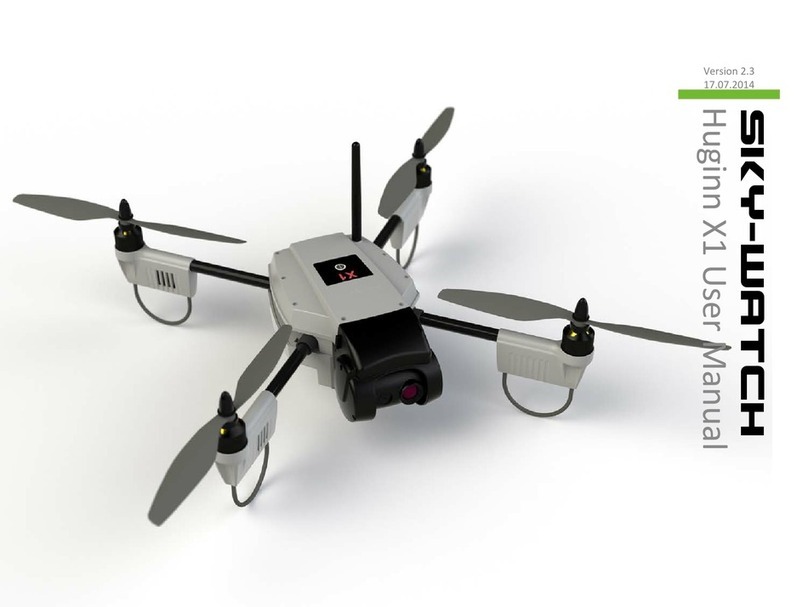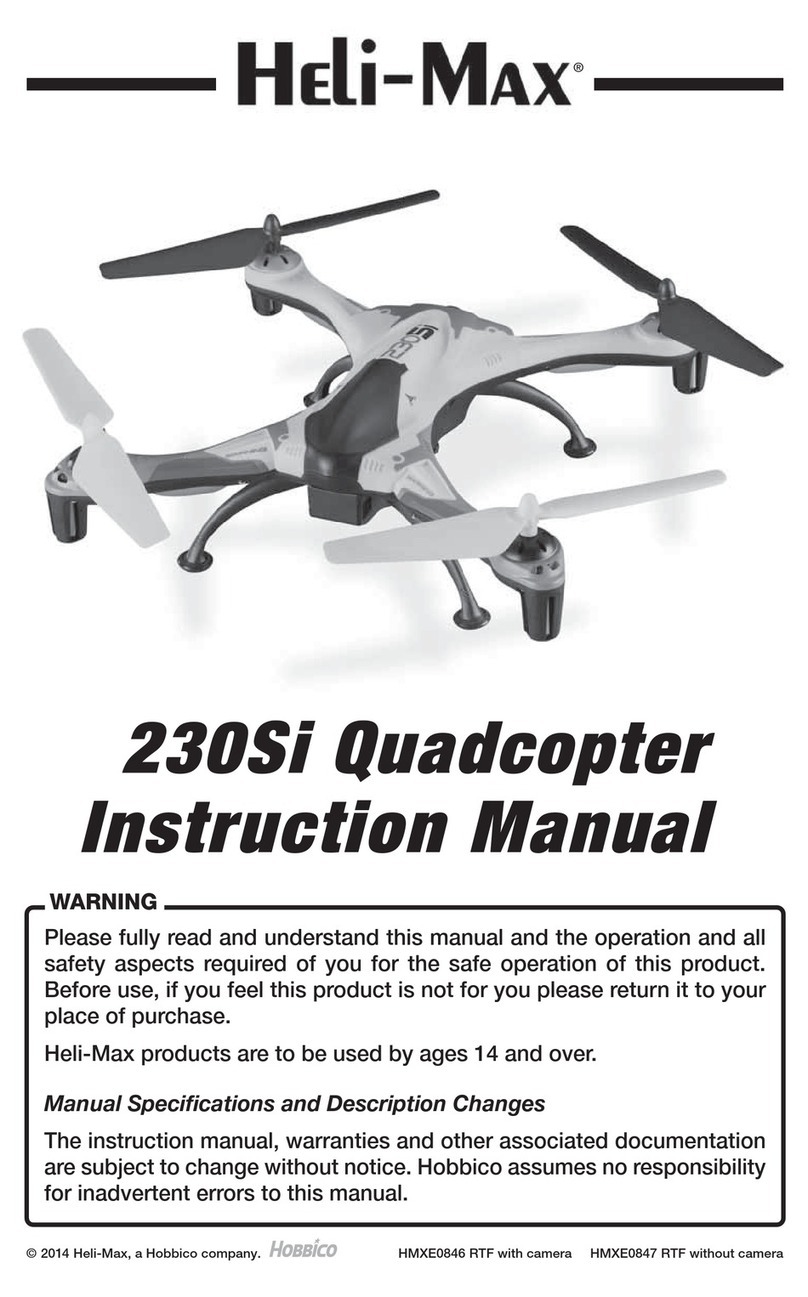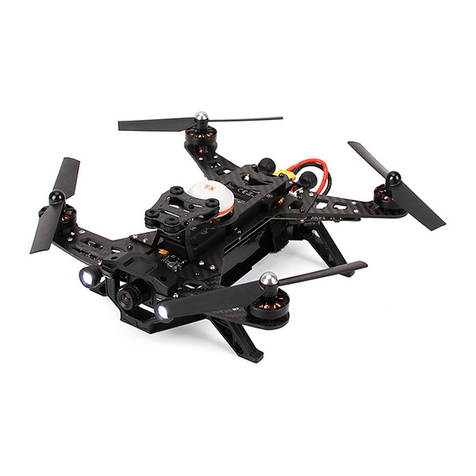Flyability Elios 3 User manual

ORIGINAL INSTRUCTIONS Page 2 of 24
Strictly confidential

EU DECLARATION OF CONFORMITY
We,
Flyability SA
EPFL INNOVATION PARK BLDG C, 1015 Lausanne, Switzerland
Tel: +41 21 311 55 00
declare under our sole responsibility that the product:
ELIOS 3 UAV with Lidar
to which this declaration relates is in conformity with the following standards or other normative
documents:
Radio Spectrum
EN 300 328 V2.2.2
Safety
EN 62368-1:2020 EN 60825-1:2014
Health
EN 62311: 2020 EN 62479: 2010
EMC
EN 55032: 2015+A11: 2020 EN 55035: 2017+A11: 2020
EN 61000-3-2: 2019/A1:2021 EN 61000-3-3: 2013/A2: 2021
EN 301 489-1 V2.2.3 EN 301 489-17 V3.2.4
RoHS
2011/65/EU,(EU) 2015/863
WEEE
2012/19/EU
REACH
2006/1907/EC
following the provisions of
-RED Directive: 2014/53/EU
-RoHS Recast Directive: 2011/65/EU (EU) 2015/863
-WEEE Directive: 2012/19/EU
-REACH Regulation: 2006/1907/EC
The Technical Construction File is maintained at:
Flyability SA
EPFL Innovation Park Bldg C, 1015 Lausanne, Switzerland
The authorized representative located within the Community is:
Dr. Adrien Briod
Chief Technology Officer
EPFL Innovation Park Bldg C, 1015 Lausanne, Switzerland
Date: July 20th, 2022
ORIGINAL INSTRUCTIONS Page 3 of 24
Strictly confidential

FCC COMPLIANCE NOTICE
This equipment must be installed and operated in accordance with provided instructions and the
antenna(s) used for this transmitter must be installed to provide a separation distance of at least 20
cm from all persons and must not be co-located or operating in conjunction with any other antenna
or transmitter. End-users and installers must be provided with antenna installation instructions and
transmitter operating conditions for satisfying RF exposure compliance.
This device complies with Part 15 of the FCC Rules. Operation is subject to the following two
conditions:
1. This device may not cause harmful interference, and
2. This device must accept any interference received, including interference that may cause
undesired operation.
Any changes or modifications not expressly approved by the party responsible for compliance could
void the user’s authority to operate the equipment.
This equipment has been tested and found to comply with the limits for a Class B digital device,
pursuant to part 15 of the FCC Rules. These limits are designed to provide reasonable protection
against harmful interference in a residential installation. This equipment generates, uses, and can
radiate radio frequency energy and, if not installed and used in accordance with the instructions, may
cause harmful interference to radio communications. However, there is no guarantee that
interference will not occur in a particular installation. If this equipment does cause harmful
interference to radio or television reception, which can be determined by turning the equipment off
and on, the user is encouraged to try to correct the interference by one or more of the following
measures:
– Reorient or relocate the receiving antenna.
– Increase the separation between the equipment and receiver.
– Connect the equipment to an outlet on a circuit different from that to which the receiver
is connected.
– Consult the dealer or an experienced radio/TV technician for help.
FCC RF EXPOSURE INFORMATION
This equipment complies with FCC radiation exposure limits set forth for an uncontrolled
environment. In order to avoid the possibility of exceeding the FCC radio frequency exposure limits,
human proximity to the antenna shall not be less than 20cm during normal operation.
IC RSS WARNING
This device complies with Industry Canada license-exempt RSS standard(s). Operation is subject to
the following two conditions: (1) this device may not cause interference, and (2) this device must
accept any interference, including interference that may cause undesired operation of the device.
Le présent appareil est conforme aux CNR d'Industrie Canada applicables aux appareils radio
exempts de licence. L'exploitation est autorisée aux deux conditions suivantes : (1) l'appareil ne doit
pas produire de brouillage, et (2) l'utilisateur de l'appareil doit accepter tout brouillage radioélectrique
subi, même si le brouillage est susceptible d'en compromettre le fonctionnement.
IC RADIATION EXPOSURE STATEMENT
This equipment complies with IC RSS-102 radiation exposure limits set forth for an uncontrolled
environment. This equipment should be installed and operated with a minimum distance of 20cm
between the radiator & your body.
Ce matériel est conforme aux limites de dose d'exposition aux rayonnements, fic rss-102 énoncée
dans un autre environnement. Cette équipement devrait être installé et exploité avec une distance
minimale de 20 entre le radiateur et votre corps.
ORIGINAL INSTRUCTIONS
Page 4 of 24

DISCLAIMER
Terms with initial capital letters shall have the following meanings:
“Agreement” means the conditions of use of this Original Instructions and any other
agreement between You and Flyability per which the Product has been delivered
to You, including but not limited to Flyability’s General Terms and Conditions.
“Flyability” means Flyability SA, a company incorporated in the Canton of Vaud in
Switzerland under federal number CH-550.1.156.670-6 (IDE CHE-348.376.646)
having its registered offices at EPFL Innovation Park BLDG C, 1015 Lausanne,
Switzerland
“Product” means all goods and services described in this document.
“You” means the person or legal entity to which the Product is delivered or who is
operating the aircraft
All rights related to this document and all information it contains are the property of Flyability.
REPRODUCTION, USE, OR DISCLOSURE TO THIRD PARTIES WITHOUT PRIOR WRITTEN
PERMISSION FROM FLYABILITY IS STRICTLY PROHIBITED.
By using the Products, software and systems of Flyability, You fully accept and consent to,
without reservation, Flyability’s warranty and liability terms as stated below, and all other terms
and conditions agreed between You and Flyability.
1. Product limited warranty
By using the Product, You hereby signify that you have read, fully understood, and agreed to this
disclaimer and the original instructions, and You agree that the Product:
(i) Will only be operated by Flyability Certified ELIOS 3 Pilots and, if required by law, with
other drone pilot licenses or any other certification necessary to pilot ELIOS 3; and
(ii) Presents a risk of physical injuries if wrongly used; and
(iii) Presents a risk of damaging Your and Third-parties’ property if wrongly used; and
(iv) May be unfitted to Your needs and purposes; and
(v) Is intended to be used by Flyability Certified ELIOS 3 Pilots for industrial and professional
purposes only; and
(vi) Should not be used under the influence of alcohol, drugs, or any substances that may
impair cognitive abilities; and
(vii) Is subject to local regulations that could prevent its use.
You shall pursue all available remedies to You according to the Agreement. The warranty shall
exclude defects due to misuse, non-observation of the Original Instructions, moisture or liquids,
explosive gas, proximity or exposure to heat at temperatures exceeding the Operating
temperature of 50 degrees Celsius, excessive strain, abuse, neglect, misapplication, and repairs or
modifications made by anyone other than Flyability or certified by Flyability. There are no express
or implied warranties, nor any representations or conditions, other than those stated in this limited
warranty and the Agreement. The remedy set forth herein and in the Agreement shall be the sole,
exclusive remedy with respect to the Product.
2. Product liability
IN NO EVENT OR UNDER ANY CIRCUMSTANCE, UNLESS EXPRESSLY STATED IN THE
AGREEMENT, SHALL FLYABILITY SA, ITS DIRECTORS, OFFICERS, OR EMPLOYEES BE LIABLE TO
YOU OR TO ANY THIRD PERSON CLAIMING RIGHTS DERIVED FROM YOUR RIGHTS, IN
CONTRACT, TORT, OR OTHERWISE, FOR INDIRECT, SPECIAL, INCIDENTAL, EXEMPLARY, PUNITIVE
OR CONSEQUENTIAL DAMAGES OF ANY KIND WHATSOEVER, EVEN IF ADVISED OF THE
POSSIBILITY OF SUCH DAMAGES INCLUDING, BUT NOT LIMITED TO, ANY DAMAGES CAUSED BY
YOU OR A THIRD PARTY WHILE OPERATING OR USING THE PRODUCT, ANY DAMAGES CAUSED
BY FAILURE OF THE ELECTRONICS OR SOFTWARE, ANY LOSS OF REVENUE, LOSS OF PROFIT,
OR LOSS OF DATA, WHETHER BASED UPON ANY ALLEGED BREACH OF WARRANTY,
REPRESENTATION OR CONDITION, CONTRACT, OR ANY OTHER CONDUCT INCLUDING
NEGLIGENCE (INTENTIONAL OR OTHERWISE), GIVING RISE TO SUCH CLAIM. A Party who relies
on a breach of the other Party’s obligations under this Agreement shall take any and all
reasonable measures in the circumstances to mitigate the consequences, including loss of profit,
ORIGINAL INSTRUCTIONS
Page 5 of 24

resulting from the breach. If the Party fails to take such measures, the Party in breach may claim a
reduction in the damages in the amount by which the consequences should have been
mitigated.
YOU SHALL NOT OPERATE THE PRODUCT IN AREAS OR UNDER CIRCUMSTANCES WHERE A
FAILURE COULD CAUSE DAMAGE AND/OR HARM TO OBJECTS AND/OR PEOPLE. YOU SHALL
READ AND UNDERSTAND THE ORIGINAL INSTRUCTIONS COMPLETELY BEFORE OPERATING
THE PRODUCT. ANY DAMAGE AND/OR HARM ARISING FROM NOT ACCURATELY FOLLOWING
THE PROCESSES AND GUIDANCE FROM THE ORIGINAL INSTRUCTIONS SHALL BE THE SOLE
RESPONSIBILITY OF THE OPERATOR OF THE UAV.
ALL USE OF THE PRODUCT IS UNDER YOUR SOLE RESPONSIBILITY, INCLUDING, BUT NOT
LIMITED TO, THE COMPLIANCE WITH APPLICABLE LAW AND REGULATIONS OF THE COUNTRY
IN WHICH THE PRODUCT IS OPERATED.
3. Data storage and usage
When You use the tablet application or any other software provided by Flyability, data regarding
the use and operation of the product, such as flight telemetry data (e.g. battery life, altitude, or
hardware identification) and operations records may be automatically or manually uploaded to a
Flyability designed server.
The provided data does not include personal data (e.g. name, address) but it does include
identification data, such as usernames that may be associated with the UAV. By using the product,
the tablet application, or any other software distributed by Flyability, or by manually providing
data to Flyability, you consent to:
(i) Our storage of any telemetry data and other data uploaded or provided to us, which
may include your username; and
(ii) Our use of any such data uploaded or provided (including your username) in
connection with providing support and services to You and to improve our products.
Authorizations and regulations
SOME COUNTRIES MAY HAVE LAWS THAT LIMIT OR PROHIBIT THE USE OF UNMANNED
AIRCRAFT. YOU ARE SOLELY RESPONSIBLE FOR SECURING ALL AUTHORIZATIONS,
CERTIFICATIONS, AND LICENSES REQUIRED FOR THE USE OF THE PRODUCT. FLYABILITY SA
DOES NOT PROVIDE ANY LEGAL ADVICE OR COUNSELING. UNDER NO EVENT SHALL
FLYABILITY BE LIABLE FOR ANY INFRINGEMENT OF ANY APPLICABLE LAW BY YOU.
ORIGINAL INSTRUCTIONS
Page 6 of 24

ELIOS 3
3 – ELIOS 3 System specifications
1 Safety
Read carefully and understand these important safety instructions
before flying to prevent any risk of accident and/or serious injuries.
1.1 Operation Safety Rules
During operation and missions with any Flyability product, please observe the following rules. Make
sure people around you have been briefed about safety accordingly.
WARNING
High-speed spinning
propeller
WARNING
Loud noise
WARNING
Bright light
Flashing Light
WARNING
Hot surfaces
MANDATORY
Read the original
instructions
MANDATORY
Wear ear protection
MANDATORY
Wear eye protection
MANDATORY
Wear head
protection
MANDATORY
Have protective
gloves
in vicinity
1. Everyone surrounding the operation, including the pilot, must wear eye, ear, and head
protection. They must have protective gloves in the vicinity . They should not wear jewelry,
1
loose clothing, or loose/long hair.
2. Apart from the spotter or the inspector, no one should talk to or otherwise distract the pilot
while the pilot is operating the drone.
3. Avoid touching the drone while the propellers are spinning. If touching the drone while it
is in flight is essential to operations, make sure that the drone is stable and touch only the
protective cage with your hands wide open and your fingers straight to prevent any of
them from entering the cage. Always wear protective gloves when doing this.
4. Do not fly close to, or directly above, people.
5. Do not look directly into the LEDs, as doing so may lead to eye injuries.
6. In case of an accident, do not try to catch the falling drone. Your safety is more important
than the drone.
7. The area around the pilot, as well as the takeoff and landing area, should be free from
people and obstacles.
1A risk assessment should be made to state additional protection (e.g. respiratory protection in dusty
environments)
ORIGINAL INSTRUCTIONS
Page 8 of 24

ELIOS 3
3 – ELIOS 3 System specifications
1.2 General Guidelines
1. The pilot MUST be a Flyability Certified ELIOS 3 Pilot and, if required by local laws, hold
other drone pilot licenses or any other certification necessary to pilot ELIOS 3.
2. A damaged propeller may break in flight, causing the drone to crash. Pieces of the broken
blade can become dangerous projectiles. Replace a propeller if it is broken, cracked, bent,
or damaged in any way. Operators and surrounding personnel MUST wear safety glasses.
3. A too large gap between the propeller tip and the duct will decrease efficiency and reduce
flight time. Replace propellers when the tips are worn down to an extent where the white
markings are no longer visible and in any case when there is visible damage or when they
have been used for 10 flight hours.
4. Debris can be ejected at high velocity when it collides with the propellers. Operators and
surrounding personnel MUST wear safety glasses.
5. The pilot should always act according to his or her best judgment, focusing on the safety of
the people and the environment in which she or he is flying. The pilot MUST brief all
personnel attending or surrounding the flight about safety. While piloting, the pilot should
not move, as doing so may cause injuries due to slipping, tripping, or falling.
6. DO NOT fly over or near people or over or near moving vehicles. When operating outdoors,
always give way to other aircraft and watch out for low flying helicopters.
7. Operating the ELIOS 3 system for extended periods of time can be stressful, tiring, and
cause muscular fatigue. The controller is equipped with a hook that can connect to a strap.
Use the provided controller strap to relieve your muscles. Using the strap will also help the
pilot avoid dropping or damaging the ground control station.
8. Using the Flashing LED function on ELIOS 3 can be tiring and stressful to the pilot and
surrounding personnel. It may in some cases trigger a seizure in people suffering from
epilepsy.
9. The motors contain magnets that can disrupt the proper functioning of medical devices or
disturb certain electronic devices located nearby.
10. DO NOT use ELIOS 3 under the influence of alcohol, drugs, or any substances that may
impair cognitive abilities.
11. A proper risk assessment MUST be performed before every flight.
12. The pilot MUST always go through the checklists before, during, and after each flight.
13. ELIOS 3, like any remotely piloted aircraft system, must be operated according to the laws
of the country and airspace in which it is used. It is the sole responsibility of the pilot to be
informed of the applicable restrictions concerning flight near people, buildings, BVLOS
(Beyond Visual Line of Sight) operations, or any other special types of operations that may
be prohibited or limited by law.
14. Use only parts provided by Flyability, genuine Flyability parts, or parts certified by Flyability.
Using other devices or parts in combination with ELIOS 3 (e.g., batteries, propellers, etc.) or
performing unauthorized modifications may result in the system malfunctioning and
might compromise safety and reliability.
15. Avoid any manual operations inside the drone’s cage while the battery is plugged in,
except for turning on and off the aircraft.
16. DO NOT wear jewelry, loose clothing, or loose/long hair when operating ELIOS 3 or while in
its vicinity.
17. Under no circumstance should objects, fingers, or any type of body part enter the drone’s
protective cage while it is armed (i.e., when the propellers are spinning), since doing so
may result in severe personal injuries and damage to the drone.
ORIGINAL INSTRUCTIONS
Page 9 of 24

ELIOS 3
3 – ELIOS 3 System specifications
18. DO NOT perform the arming sequence to arm the drone (i.e., making the propellers spin)
during the removal or insertion of the battery, or while objects, fingers, or any other body
parts are inside the protective cage.
19. Avoid touching the drone while the propellers are spinning. If touching the drone while it
is in flight is essential to operations, make sure that it is stable and touch only the
protective cage with your hands wide open and your fingers straight to prevent any of
them from entering the cage. Always wear protective gloves when doing this.
20. Propellers have sharp edges. For this reason, protective gloves MUST be worn when
changing a propeller.
21. If the drone is unresponsive due to a malfunction, disarm it and DO NOT insert your hands
or fingers into the cage until 1 hour after the incident. Wear protective gloves to disconnect
the battery.
22. After a strong impact (more than 1m free fall), do not touch the drone as it may explode or
catch fire. If the aircraft is in an enclosed place, or near to an explosive or flammable
environment, you may carefully place it in a properly ventilated area. The aircraft must
remain under supervision for at least 1 hour following a strong impact. A risk assessment
should be performed prior to attempting to use the drone again.
23. It is recommended to use only transport cases approved by Flyability to transport the
ELIOS 3..
24. Carefully read the Battery Safety Guidelines and the User Manual before using the ELIOS 3
system.
25. During a flight, parts of the aircraft can become very hot. Wait 3 minutes after disarming
the drone for these parts to cool down and access the battery. If time is a constraint, you
may use protective gloves to change the battery during the cooling period.
26. After a flight, wait 3 minutes before touching the following parts:
a. Motors
b. Lighting panels
c. Lidar assembly, if mounted
ORIGINAL INSTRUCTIONS
Page 10 of 24

ELIOS 3
3 – ELIOS 3 System specifications
1.3 Environmental Awareness
Flight in unsafe environmental conditions might lead to accidents or damage to the
equipment
1. Do not fly close to people.
2. ELIOS 3 is not waterproof. Do not fly under heavy rain/snow or in very humid
environments. Moisture can cause damage to the drone’s electronics.
3. Store the ELIOS 3 system in a dry environment that is protected from sunlight and kept
between 0°C and 30°C.
4. Mechanical parts may deteriorate more rapidly in dusty, sandy, or corrosive environments.
Clean all mechanical parts thoroughly to remove dust after each flight.
5. The propellers may blow harmful dust, vapor, or gasses towards you. Cover this topic in
your risk assessment, and if necessary, have yourself and surrounding personnel wear eye
protection and respiratory protection.
6. The cage protects the drone from impacts, but small objects can penetrate the cage and
cause damage to the drone and its propellers or create high velocity projectiles. In flight,
avoid protruding objects and/or any falling objects. In case of doubt about whether such
precautions are needed, performing a risk assessment is recommended and eye
protection MUST be worn.
7. Flying in low air density environments such as in a combination of high altitude, high
temperature, and high humidity, will reduce flight time, control authority and collision
resilience. Do not fly at density altitudes over 5000m.
8. The wind may have severe effects on ELIOS 3. With the wind higher than 5m/s when flying
in ASSIST mode, Flyability cannot guarantee ELIOS 3’s ability to hold its position without
pilot input on the sticks . With the wind above 7m/s, Flyability cannot guarantee the
stability or flying capability of ELIOS 3.
9. Very cold temperatures lead to reduced flight times. Do not fly in temperatures below 0°C.
If you need to fly in an environment below 10°C, heat the batteries to 25°C prior to the flight
and observe the safety practices while flying that are described in the Battery Safety
Guidelines.
10. Hot temperatures—above 40°C—will interfere with battery performance. The pilot should
observe the safe practices regarding the battery described in the Battery Safety Guidelines.
11. Motor performance is automatically reduced to avoid overheating. For this reason, the
collision tolerance of the drone cannot be guaranteed above 50°C. Flyability cannot
guarantee the drones flight capability and stability if not used in temperatures between
0°C to 50°C.
12. The output power of the lighting system will automatically be reduced in high
temperature environments.
13. The electronics and battery are cooled down by the airflow generated by the propellers.
Leaving the drone on without flying will eventually make the electronics and sensors
overheat and shutdown.
14. After a flight in an environment above 40°C, use gloves for changing the battery or wait for
at least 10 minutes for the drone to cool down in a zone where the temperature is below
30°C.
15. It is not recommended to operate the aircraft close to power lines, power transformers, or
other areas with high electromagnetic disturbances since these may cause severe effects
on the sensors and transmission system, impacting the aircraft’s stability and flying
capability.
ORIGINAL INSTRUCTIONS
Page 11 of 24

ELIOS 3
3 – ELIOS 3 System specifications
16. The drone is loud. Wearing ear protection is mandatory when flying in enclosed areas or
when the aircraft is operating close to personnel.
17. If you are flying in a confined or enclosed place, avoid being inside this same space while
the drone is flying. Do not forget this topic in your risk assessment.
18. Avoid flying in a biohazard environment. If this is unavoidable, avoid flying close to people
and have yourself and surrounding personnel wear eye protection and respiratory
protection as the propellers may blow contaminated particles to you. Also, wear gloves and
appropriate protection while manipulating the drone and its equipment until further
decontamination. Do not forget this topic in your risk assessment.
19. ELIOS 3 should not be used in or near explosive or flammable environments.
1.4 Maintenance guidelines
To ensure safe and reliable maintenance of your ELIOS 3, observe the following preventive actions:
1. Change cage elements whenever they are structurally damaged.
2. A damaged propeller may break, and pieces of the broken blade can become dangerous
projectiles and reduce the drone’s reliability. Replace a propeller if it is broken, cracked,
bent, or damaged in any way, or when the tip is worn down to beyond the tip marking.
3. Re-torque the propeller nuts with the provided 1.4Nm torque screwdriver every 5 flights.
4. Change the propeller after 10 hours of flight.
5. Change the motor after 50 hours of flight when used in a clean environment. Usage in an
environment with high levels of dust will significantly reduce the motor life time.
ORIGINAL INSTRUCTIONS
Page 12 of 24

ELIOS 3
3 – ELIOS 3 System specifications
2 Checklists
These checklists present proposed workflows to help to operate the ELIOS 3 system in a safe and
efficient manner.
2.1 Mission Planning Guidelines
This checklist presents the steps that must be followed while planning an operation.
1. Has the Method Statement been filled?
The Method Statement (MS) is a document specifying all the different steps that will be performed during the
inspection. The MS also specified all the required equipment needed to fulfill the mission. The “Method
Statement—Template” document is provided on our website as a template you can use to create your own
Method Statements.
2. Has the Risk Assessment been filled?
The Risk Assessment (RA) is a document specifying all the risks that can occur during the mission. The RA also
lists the mitigations that may reduce these risks. The “Risk Assessment—Template” document is provided on
our website as a template you can use to create your own Risk Assessments.
3. Is the environment in which the ELIOS 3 will
be operated safe?
The flight environment must comply with the limitations presented in the “Environment Awareness” section of
the Original Instructions.The presence of dangerous elements must have been stated in the RA and MS
documents.
4. Is there any hazard to the pilot?
If the ELIOS 3 is flying in environments that can present bio-hazards or chemical hazards (sewers, pandemic
areas, carcinogenic materials, etc.), the risk should be listed within the MS and/or the RA, and appropriate
measures must be taken (gloves, eye protection, mask, etc. to address the hazard.
5. Do you have adequate Personal Protective
Equipment (PPE)?
The following PPE must always be worn:
- Eye protection.
- Ear protection.
- Hard hat.
- Have protective gloves in vicinity.
You must be aware of the effects of operating ELIOS 3 in your working environment and dress accordingly:
- If the environment is dusty, wear respiratory protection.
- If the environment contains hazardous elements, wear the corresponding PPE.
Mission-specific PPE requirements and/or recommendations must be defined in the MS and/or RA documents.
6. Do you have the proper flight authorization?
If you perform an outdoor flight, depending on the area and on the country in which you will conduct your
flight, you might need a specific authorization. Research the airspace in which you plan to fly and contact the
aeronautical agency in your country as needed for up-to-date information.
7. Use of the aircraft
Flyability products are NOT listed as dual-use products. Do not use the system with the intent to harm.
ORIGINAL INSTRUCTIONS
Page 13 of 24

ELIOS 3
3 – ELIOS 3 System specifications
2.2 Aircraft Inspection
The aircraft inspection checklist ensures that the ELIOS 3 is ready to fly. An inspection that includes all
of the items on the checklist should be performed before each flight and after having transported
the ELIOS 3. The preflight check is displayed on the tablet before every flight.You may also memorize
the mnemonic PEACE to help you remember the Aircraft Inspection Checklist (see below for
information on what each letter stands for in the mnemonic).
PROPELLERS TIGHT
Propellers are tight on the motors. Use the 1.4Nm torque screwdriver issued in the toolbox
to retighten the nuts.
ELECTRICAL MOTORS MOVE FREELY
Check whether the motors rotate freely to make sure that no dust, sand, or other particles
are inside them.
AIRCRAFT CLEAR OF DAMAGE
Visually inspect the aircraft to make sure it is undamaged. Pay particular attention to
carbon parts, propellers, payloads, and LED panels.
CAMERA LENS AND SENSORS CLEAN
Clean the camera lens and the sensors using the lens cleaner. Cleaning the lens and
sensors will ensure better image quality and better stability for the drone. Check the
camera lens for fog or condensation. If an additional payload with a sensor is mounted,
make sure it is clean. ( lidar payload for example)
ELECTRICAL SUPPLY UNDAMAGED | SECURED
The battery is fully charged, visually in proper condition, and secured with the locking
mechanism.
ORIGINAL INSTRUCTIONS
Page 14 of 24

ELIOS 3
3 – ELIOS 3 System specifications
2.3 Take-off Checklist
Perform the take-off checklist before each flight. Memorize the mnemonic SAFE to help you
remember the Take-off Checklist ( (see below for information on what each letter stands for in the
mnemonic).
SAFETY BRIEFING PERFORMED
All personnel surrounding the operation have been briefed about safety using the
Basic Safety Rules and are aware that they should avoid distracting the pilot.
AIRCRAFT CHECKED
The preflight inspection ensures the ELIOS 3 is ready to fly.
FLIGHT PLAN DONE
The flight plan ensures that the pilot will fly ELIOS 3 in a safe way and will gather data
in a consistent way.
ENVIRONMENT CHECKED
Make sure you are flying in a safe environment and complying with the limitations of
the drone as stated in the Environmental Awareness section.
ORIGINAL INSTRUCTIONS
Page 15 of 24

ELIOS 3
3 – ELIOS 3 System specifications
3 ELIOS 3 System specifications
AIRCRAFT
CONFIGURATION
Ducted fan quadcopter
DATA INTERFACE
USB-c port using Inspector (requires drone to be powered by its
battery)
USER INTERFACE
One back-lit power button with RGB lights to put the drone in
different states without using the remote controller
DIMENSIONS
480mm wide (18.9 in)
380mm high (13.8 in)
PROPELLERS
4 propellers, 127mm (5 inches)
TAKEOFF WEIGHT
Base model ~1900 g (< 4.2 lbs)
With Lidar payload ~ 2350 g (< 5.2 lbs)
MAX FLIGHT TIME
Base model - Up to 12.5 min in ideal conditions with new battery
With Lidar payload - Up to 9 min in ideal conditions with new battery
MAX ASCENT / DESCENT
SPEED
Assist and Atti mode: 1.3 m/s (4.3 ft/s)
Assist-Sport mode: 2 m/s (6.6ft/s)
MAX SPEED
Assist mode: 1.5 m/s (4.9 ft/s)
Assist-Sport mode: 2 m/s (6.6ft/s)
Atti mode: 5 m/s (16.4 ft/s)
Sport mode: 7 m/s (23 ft/s)
MAX WIND RESISTANCE
5 m/s (Assist mode); 16.4 ft/s
7 m/s (Sport mode); 23 ft/s
MAX OPERATING ALTITUDE
5000m (density altitude)
FLIGHT CONTROL SENSORS
IMU, magnetometer, barometer, 3 computer vision cameras and ToF
distance sensor
MATERIALS
Carbon fiber - kevlar composites, magnesium alloy, aeronautical
grade aluminum, high-quality thermoplastics
OPERATING TEMP.
0 ºC to 50 ºC (32 °F to 122 °F)
2
FLIGHT MODES
ASSIST : Assist mode
ASSIST-SPORT : Assist-Sport mode
ATTI : Attitude mode
SPORT : Sport mode
FAIL-SAFE
Auto-landing on signal lost
OPERATING FREQUENCY
2412 – 2462 MHz (UAV to RC)
2Additional precautions must be taken between 0-10ºC and 40-50ºC. Stability, flight performance,
and flight time might be reduced by extreme temperatures.
ORIGINAL INSTRUCTIONS
Page 16 of 24

ELIOS 3
3 – ELIOS 3 System specifications
MAXIMUM TRANSMITTED
POWER (EIRP)
2.4 GHz: 29.68 dBm (FCC); ≤20 dBm (CE); ≤10 dBm/MHz (MIC)
INGRESS PROTECTION
E3 with basic inspection payload: Splash and dust resistant,
equivalent to at least IP44
Lidar payload: IP68
NOISE LEVEL
83 dB(A) with Lidar payload
ONBOARD COMPUTER
Nvidia Xavier NX onboard computer with custom Linux OS
STANDBY TIME ON FULL
BATTERY
5000h or ~7 months
LIDAR PAYLOAD
LIDAR SENSOR
Ouster OS0-32 beams sensor
SMART BATTERY
RATED CAPACITY
4350 mAh
NOMINAL VOLTAGE
22.8 V
BATTERY TYPE
LiPo 6S HV Smart Battery:
- LED, button and user interface for SOC monitoring, etc
- Improved safety during charge cycle (protection for: overcharge,
overcurrent, overvoltage, over/under-temperature)
- Accurate state-of-health and state-of-charge estimation
- Plug-and-play charging
- Self-balancing
- Storage self-discharge
- Cycle counter
- Battery ID
SAFETY ALARM
Audible warning when battery voltage is low
ENERGY
99.2 Wh
CHARGING TIME
1 h
BATTERY CHANGE TIME
< 10s by means of plug and play battery mechanism
COMPLIANCE
Approved for carry-on luggage.
Complies with IATA Dangerous Good Regulations
NET WEIGHT
620 g ; 1.4 lbs
OPERATING TEMPERATURE
10°C -40°C (50°F - 104°F)
additional precautions must be taken between 0-10ºC. Stability, flight
performance and flight time might be reduced.
CHARGING TEMPERATURE
0 - 45°C ; 32°F - 113°F
MAX CHARGING POWER
150W AC power
CHARGER
Elios 3 Smart Battery Charger
BATTERY SHELF TIME
250 days when stored at ~20°C and at 50% SOC
BATTERY LIFE TIME
50 flights
ORIGINAL INSTRUCTIONS
Page 17 of 24

ELIOS 3
3 – ELIOS 3 System specifications
PAYLOAD CHASSIS
PAYLOAD HEAD
Damped for vibrations
CAMERA POD UPWARD
TILT
+90 degrees
CAMERA POD
DOWNWARD TILT
-90 degrees
PAYLOAD PROTECTION
Frontal shock absorbers.
MAIN CAMERA
SENSOR
1/2.3" CMOS
Effective Pixels: 12.3 M
Sensitivity: Optimized for low light performance
PHOTO FORMATS
JPG
VIDEO FORMATS
MOV
VIDEO RECORDING
RESOLUTIONS
4k Ultra HD: 3840 x 2160 at 30 fps
FHD: 1920 x 1080 at 30 fps
VIDEO STREAMING
RESOLUTION
FHD: 1920 x 1080 at 30 fps
PHOTO RECORDING
RESOLUTION
4000 x 3000, up to 40 pictures
MOVIE FOV
114° horizontal, 131° diagonal
PHOTO FOV
119° horizontal, 149° diagonal
TOTAL VERTICAL FOV
approximately 260° including camera tilt
LENS
2.71 mm focal length
Fixed focal
CONTROL MODES
Auto mode with manual EV compensation
FILE STORAGE
128 GB MicroSD card (onboard the aircraft)
SUPPORTED FILE SYSTEM
exFAT
ORIGINAL INSTRUCTIONS
Page 18 of 24

ELIOS 3
3 – ELIOS 3 System specifications
THERMAL CAMERA
SENSOR
Lepton 3.5 FLIR
VIDEO RECORDING
RESOLUTION
160 x 120 at 9 fps
LENS
FOV 56° x 42°, Depth of field 15cm to infinity
SENSITIVITY (NEDT)
<50 mK
TEMPERATURE RANGE
-10°C to 140°C (14°F to 284°F)
WAVELENGTH (LWIR)
8-14 μm
LIGHTING SYSTEM
TYPE
High-efficiency LEDs for even lighting in front, top and bottom,
optimized for low impact of dust on picture quality.
CONTROL
From the remote controller, adaptive light beam controlled by camera
pitch
MODES
Normal mode (4x panels used)
Dustproof lighting (2x outer panels used only)
Selective/oblique lighting (left or right side only)
LIGHT OUTPUT
Designed for 16k lumens
OPERATION SAFETY AND CRASHWORTHINESS
NAVIGATION LIGHTS
One RGB navigation light on the rear of the drone
PROTECTION CAGE
Carbon fiber cage with soft coating, modular subcomponents for
maintenance ease, and thermoplastic elastomer suspensions.
COLLISION TOLERANCE
Tolerant to full stick collisions in SPORT-ASSIST on flat walls with lidar
payload installed. (<2m/s)
BATTERY LATCH SAFETY
SYSTEM
Sensor embedded in battery mechanism to alarm customer with
visual warning on drone and in Cockpit if battery lever is not closed
correctly.
FAIL SAFE
AUTO-landing on signal list
ORIGINAL INSTRUCTIONS
Page 19 of 24

ELIOS 3
3 – ELIOS 3 System specifications
REMOTE CONTROLLER
OPERATING FREQUENCIES
2412 – 2462 MHz (RC to UAV)
MAX TRANSMISSION
DISTANCE
Up to 500 m in direct line of sight in ideal RF conditions
MAXIMUM TRANSMITTED
POWER (EIRP)
2.4 GHz: 29.68 dBm (FCC); ≤20 dBm (CE); ≤10 dBm/MHz (MIC)
WEIGHT
1760 g with tablet holder
OPERATING TEMP.
-10°C to 45°C
OUTPUT PORT
USB-c
BATTERY
2x 6700 mAh 1S In Series
CONTROLS
Aircraft control and payload settings
BATTERY CHARGER
12 V / 24 W
BATTERY CHARGING TIME
<2h30min for 0-80% at room temperature
<4h for 0-100% at room temperature
BATTERY CHARGING
TEMPERATURE RANGE
10°C to 35°C
BATTERY LIFE TIME
300 cycles
OPERATING TIME ON FULL
BATTERY
>5h at room temperature
TABLET
MODEL
Samsung Galaxy Tab S7 or S8
BATTERY CHARGER
USB 5V
OPERATING TEMP.
-10 °C to 50 °C
CHARGING TEMP.
0 °C to 40 °C
CHARGING TIME
5 hours
WEIGHT
500 g
TRANSPORT CASE
DIMENSIONS
65 x 45 x 55 cm
WEIGHT
13 kg
ORIGINAL INSTRUCTIONS
Page 20 of 24
Other manuals for Elios 3
3
Table of contents
Other Flyability Quadcopter manuals


